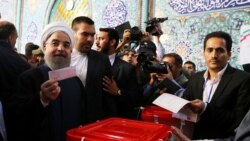Pretty rousing tune, this:
Here's a video of ex-pats voting that has been shared by the state-owned channel Press TV:
Some analysis:
Speaking of analysis, David Patrikarakos has written this piece for RFE/RL on the possible ramifications of Iran's election:
Iran's Younger Generation Positioned To Restore Political Roar
When Mahmud Ahmadinejad was elected to a second term as president in 2009 as a result of what is widely regarded as vote-rigging, Iran's younger generation played a leading role in the massive street protests that ensued and gave birth to the opposition Green Movement.
Iran's rulers were shaken. For the first time since the days of the shah, Iranians screamed "death to the dictator!" from Tehran's rooftops. Iran's youth were energized -- and angry.
It was Iran's younger generation (60 percent of the country's population is under the age of 30) that was at the heart of the Green Movement, and it was that generation's political spirit that the government sought to crush. The heavy-handed clampdown -- forever seared into memory by the shooting death of 26-year-old philosophy student and protester Neda Agha Soltan -- eventually muted the mass street demonstrations, jailed the moderate opposition's most ardent supporters and leaders, and allowed the establishment to continue on almost as before.
For Iran's young, however, it was a different story. Bereft of morale or leadership, they became increasingly apolitical under the second term of the virulently anti-Western Ahmadinejad and watched -- almost helplessly -- as their country became more isolated and more mistrusted and more extreme.
It was a source of depression for many Iranians, but an interesting thing happened: as young people became increasingly disenfranchised from politics, they poured their energies into other areas. Recent years have witnessed an explosion of creativity in art, music and, above all, theater.
As Ahmadinejad railed against the West, Iranian youth sculpted and painted and wrote. As he refused to negotiate over Iran's nuclear program, they directed plays and made underground documentaries. They created an oasis of culture in a political desert.
Past Leaves Opening For Future
Iran has always been autocratic -- the 1979 Islamic Revolution merely replaced shahs with clerics. Presidential elections in Iran are essentially a tiny democratic tick on an otherwise dictatorial body politic.
But in its short life the country's 1905-11 Constitutional Revolution provided a lasting foundation for a parliament and other hallmarks of democracy that could not be abandoned decades later by the founders of the Islamic republic.
Preeminent among the lasting democratic ideas was the holding of elections -- prime-ministerial (and later presidential) polls every four years, and parliamentary every two years. Iran's revolutionaries preserved this tradition as they recalibrated the state and rewrote the constitution to suit their new, Islamic, republic.
The new model features the election of presidents -- whose power pales in comparison to that of the supreme leader but who have significant influence on domestic and foreign policy and serve as the face of the nation abroad -- but this doesn't mean that they emerge from a democratic exercise.
Read the entire article here.




